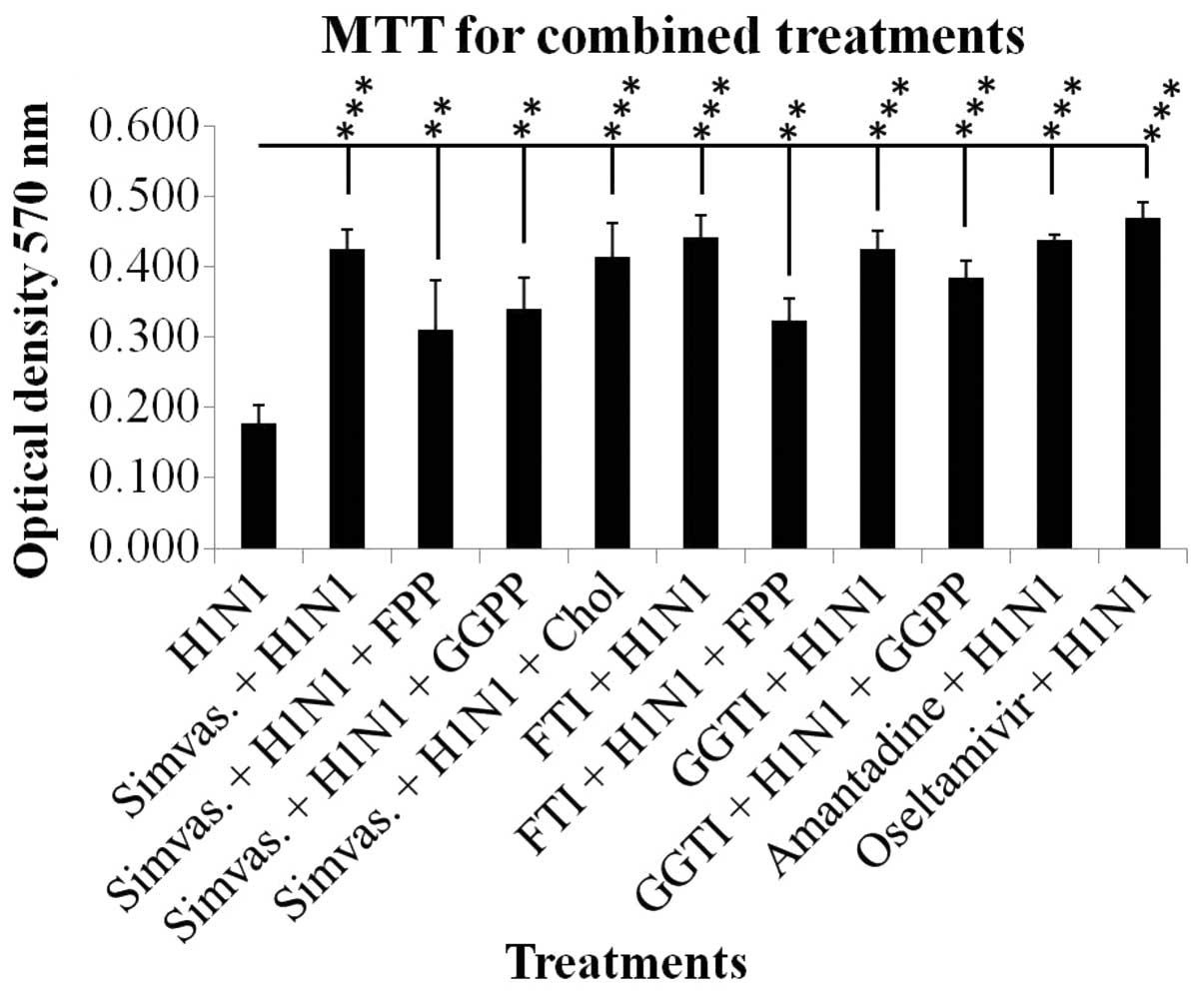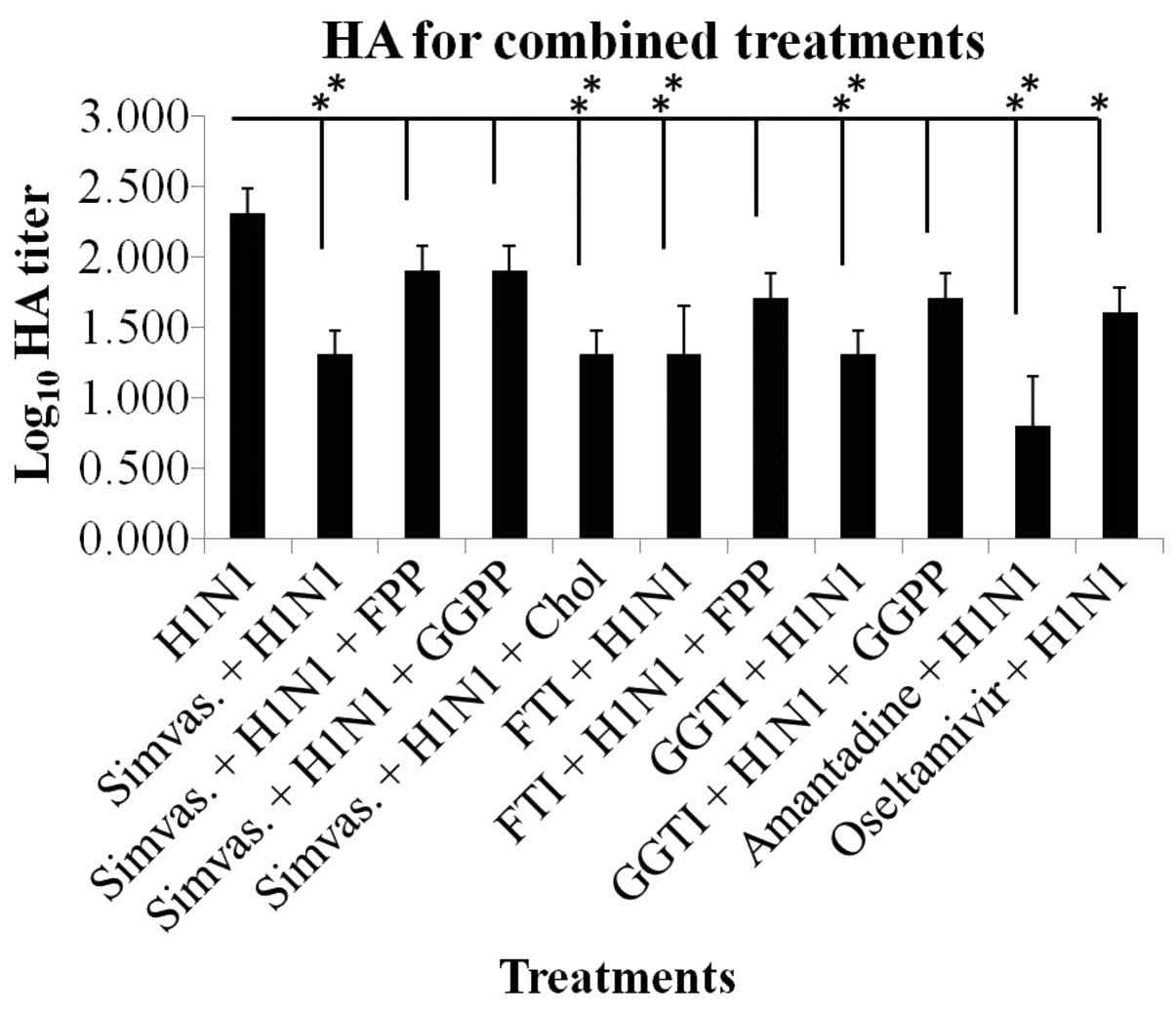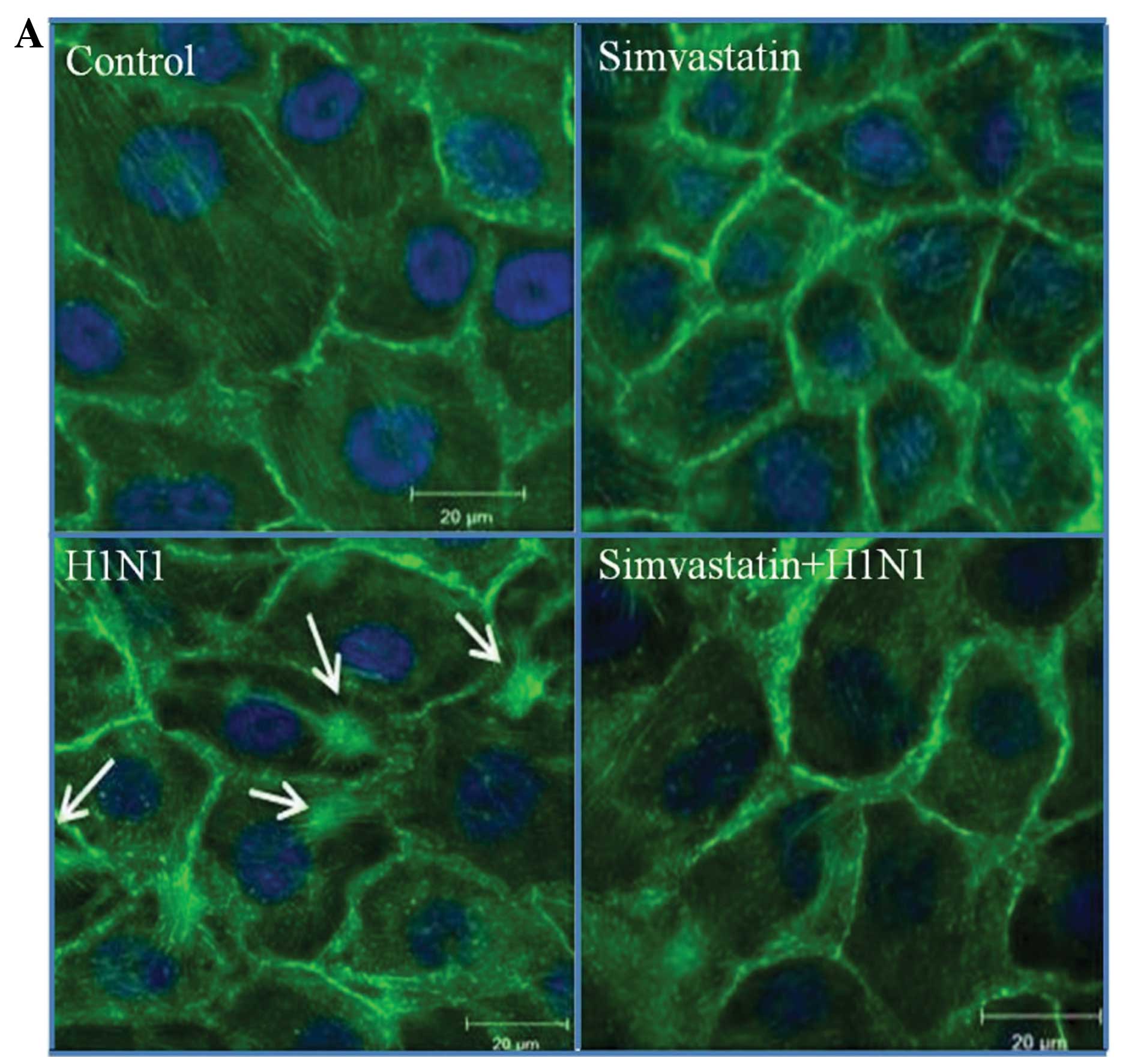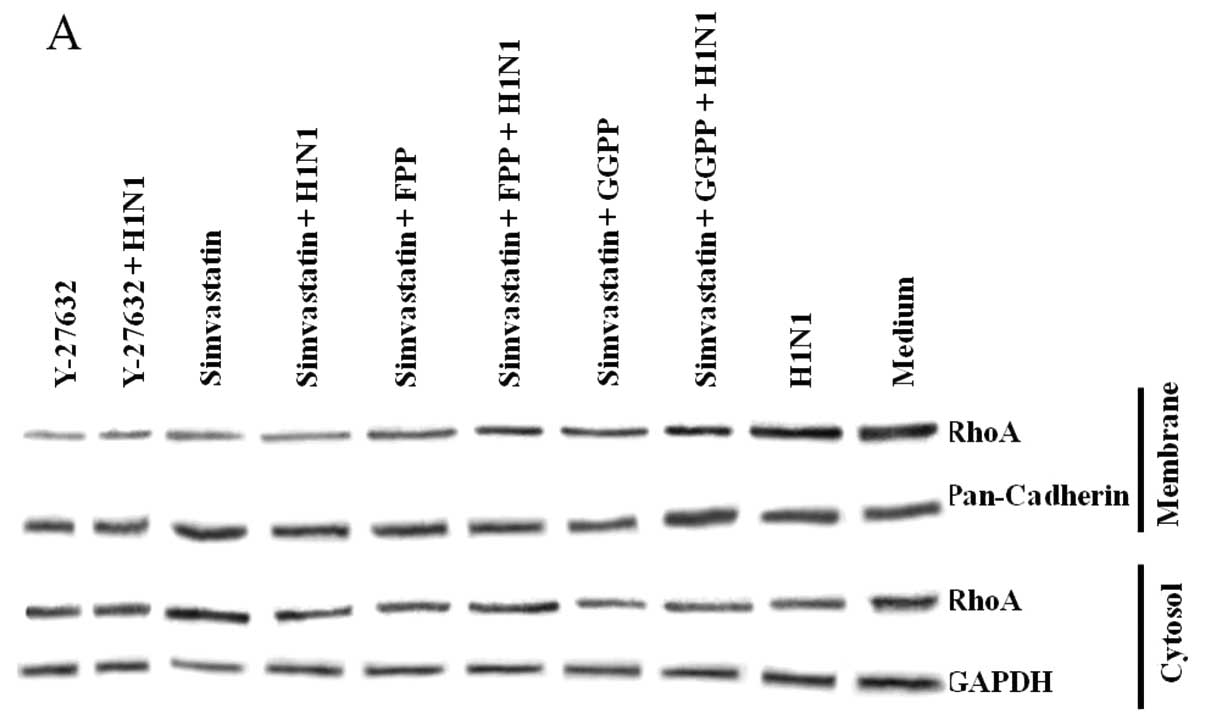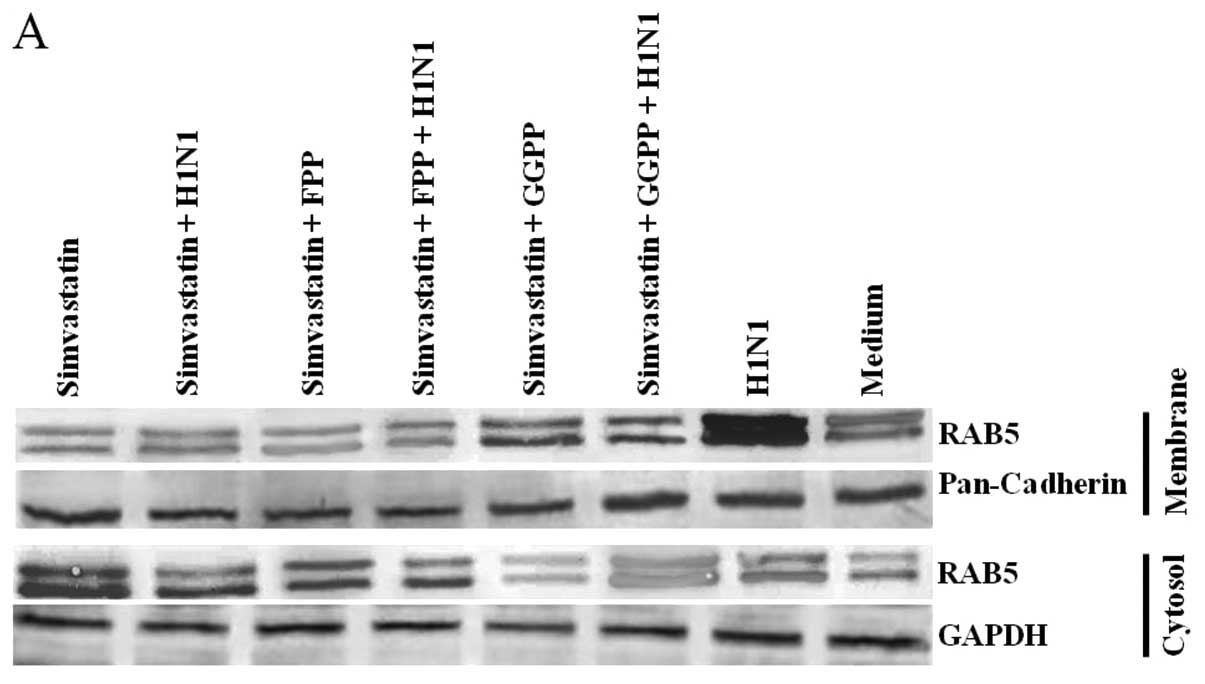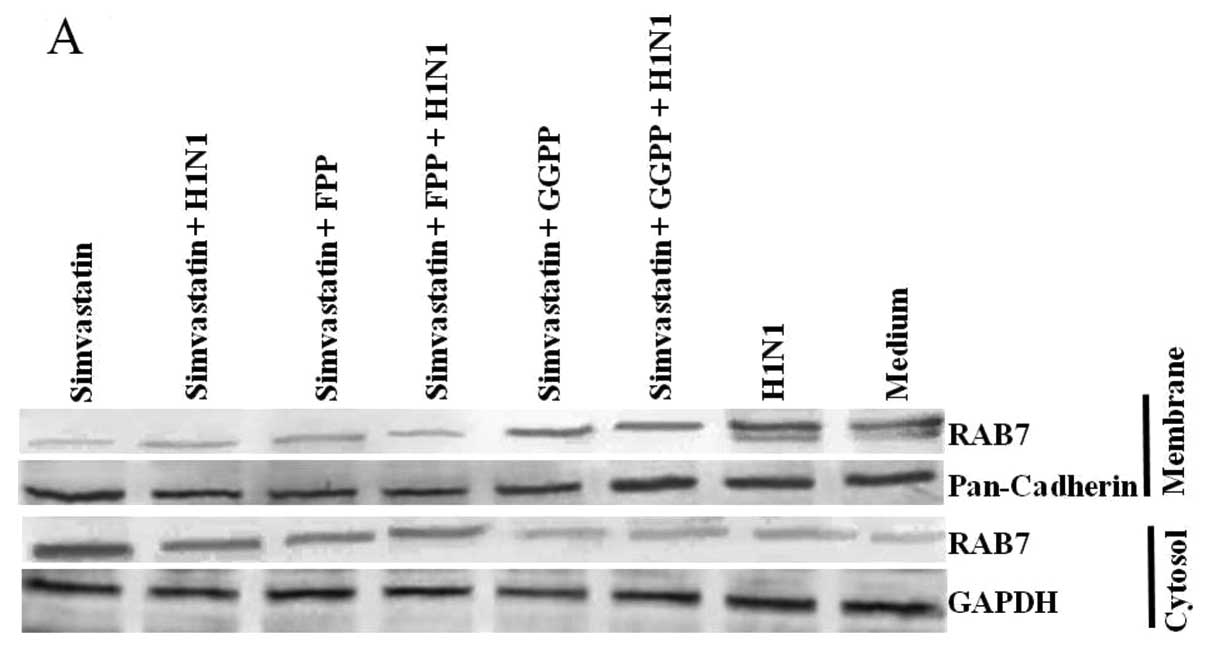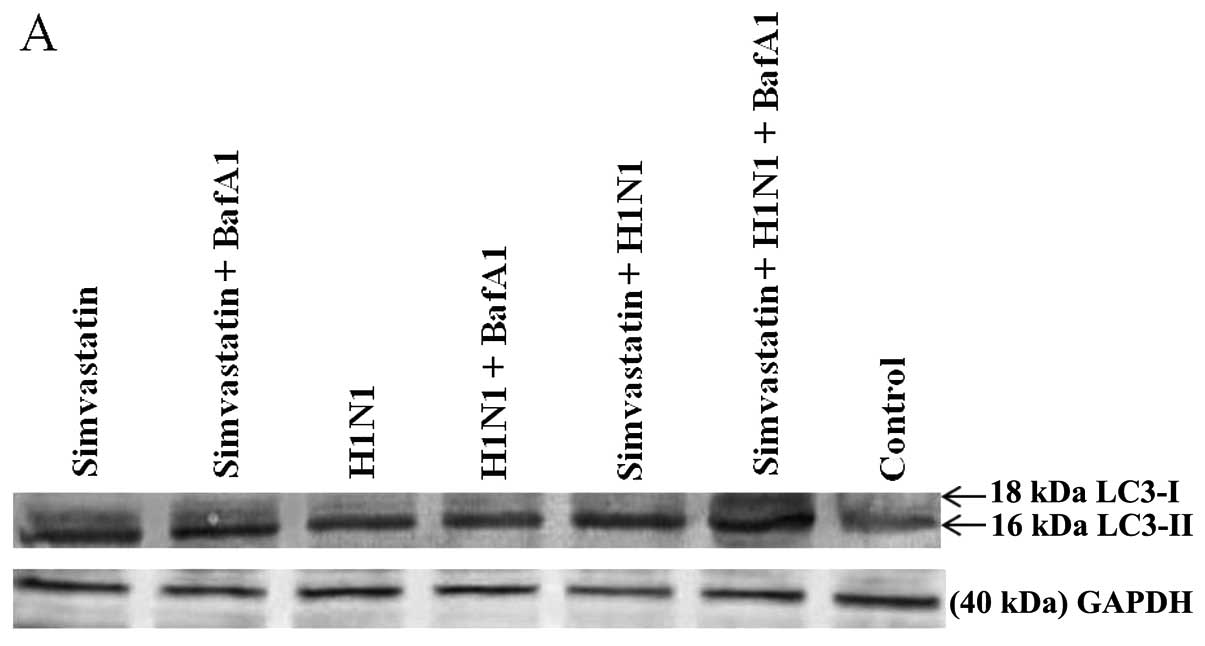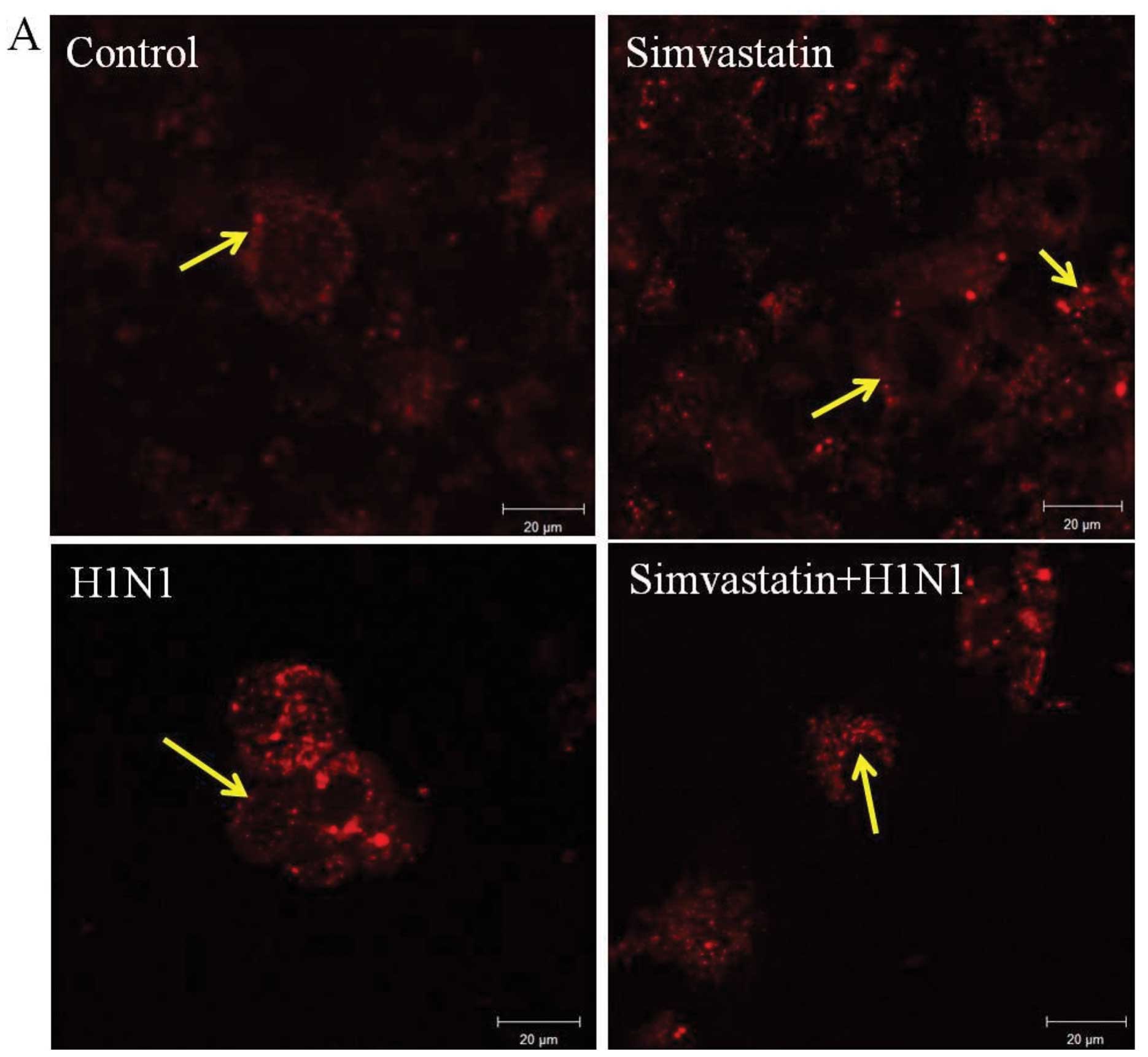|
1
|
Cloutier A, Marois I, Cloutier D,
Verreault C, Cantin AM and Richter MV: The prostanoid
15-deoxy-Δ12,14-prostaglandin-j2 reduces lung inflammation and
protects mice against lethal influenza infection. J Infect Dis.
205:621–630. 2012.
|
|
2
|
Fedson DS: Confronting an influenza
pandemic with inexpensive generic agents: can it be done? Lancet
Infect Dis. 8:571–576. 2008. View Article : Google Scholar : PubMed/NCBI
|
|
3
|
Calero M, Chen CZ, Zhu W, et al: Dual
prenylation is required for Rab protein localization and function.
Mol Biol Cell. 14:1852–1867. 2003. View Article : Google Scholar : PubMed/NCBI
|
|
4
|
Bright RA, Shay DK, Shu B, Cox NJ and
Klimov AI: Adamantane resistance among influenza A viruses isolated
early during the 2005–2006 influenza season in the United States.
JAMA. 295:891–894. 2006.
|
|
5
|
Hayden FG: Antiviral resistance in
influenza viruses-implications for management and pandemic
response. N Engl J Med. 354:785–788. 2006. View Article : Google Scholar
|
|
6
|
Dharan NJ, Gubareva LV, Meyer JJ, et al:
Infections with oseltamivir-resistant influenza A (H1N1) virus in
the United States. JAMA. 301:1034–1041. 2009. View Article : Google Scholar : PubMed/NCBI
|
|
7
|
Fedson DS: Pandemic influenza: a potential
role for statins in treatment and prophylaxis. Clin Infect Dis.
43:199–205. 2006. View
Article : Google Scholar : PubMed/NCBI
|
|
8
|
Haidari M, Zhang W, Ganjehei L, Ali M and
Chen Z: Inhibition of MLC phosphorylation restricts replication of
influenza virus-A mechanism of action for anti-influenza agents.
PLoS One. 6:e214442011. View Article : Google Scholar : PubMed/NCBI
|
|
9
|
Whittaker GR: Intracellular trafficking of
influenza virus: clinical implications for molecular medicine.
Expert Rev Mol Med. 3:1–13. 2001. View Article : Google Scholar : PubMed/NCBI
|
|
10
|
Rothberg MB and Haessler SD: Complications
of seasonal and pandemic influenza. Crit Care Med. 38(Suppl 4):
e91–e97. 2010. View Article : Google Scholar : PubMed/NCBI
|
|
11
|
de Jong MD, Simmons CP, Thanh TT, et al:
Fatal outcome of human influenza A (H5N1) is associated with high
viral load and hypercytokinemia. Nat Med. 12:1203–1207.
2006.PubMed/NCBI
|
|
12
|
Wilkins C and Gale M Jr: Recognition of
viruses by cytoplasmic sensors. Curr Opin Immunol. 22:41–47. 2010.
View Article : Google Scholar : PubMed/NCBI
|
|
13
|
Uetani K, Hiroi M, Meguro T, et al:
Influenza A virus abrogates IFN-gamma response in respiratory
epithelial cells by disruption of the Jak/Stat pathway. Eur J
Immunol. 38:1559–1573. 2008. View Article : Google Scholar : PubMed/NCBI
|
|
14
|
Osterholm MT: Preparing for the next
pandemic. New Engl J Med. 352:1839–1842. 2005. View Article : Google Scholar : PubMed/NCBI
|
|
15
|
Darwish I, Mubareka S and Liles WC:
Immunomodulatory therapy for severe influenza. Expert Rev Anti
Infect Ther. 9:807–822. 2011. View Article : Google Scholar : PubMed/NCBI
|
|
16
|
Wang CY, Liu PY and Liao JK: Pleiotropic
effects of statin therapy: molecular mechanisms and clinical
results. Trends Mol Med. 14:37–44. 2008. View Article : Google Scholar : PubMed/NCBI
|
|
17
|
Fessler MB, Young SK, Jeyaseelan S, et al:
A role for hydroxy-methylglutaryl coenzyme A reductase in pulmonary
inflammation and host defense. Am J Respir Crit Care Med.
171:606–615. 2005. View Article : Google Scholar : PubMed/NCBI
|
|
18
|
Sun X and Whittaker GR: Role for influenza
virus envelope cholesterol in virus entry and infection. J Virol.
77:12543–12551. 2003. View Article : Google Scholar : PubMed/NCBI
|
|
19
|
Cheng J, Ohsaki Y, Tauchi-Sato K, Fujita A
and Fujimoto T: Cholesterol depletion induces autophagy. Biochem
Biophys Res Commun. 351:246–252. 2006. View Article : Google Scholar : PubMed/NCBI
|
|
20
|
Terblanche M, Almog Y, Rosenson RS, Smith
TS and Hackam DG: Statins and sepsis: multiple modifications at
multiple levels. Lancet Infect Dis. 7:358–368. 2007. View Article : Google Scholar : PubMed/NCBI
|
|
21
|
Watts KL, Sampson EM, Schultz GS and
Spiteri MA: Simvastatin inhibits growth factor expression and
modulates profibrogenic markers in lung fibroblasts. Am J Respir
Cell Mol Biol. 32:290–300. 2005. View Article : Google Scholar : PubMed/NCBI
|
|
22
|
Alexeeff SE, Litonjua AA, Sparrow D,
Vokonas PS and Schwartz J: Statin use reduces decline in lung
function: VA Normative Aging Study. Am J Respir Crit Care Med.
176:742–747. 2007. View Article : Google Scholar : PubMed/NCBI
|
|
23
|
Bohn W, Rutter G, Hohenberg H, Mannweiler
K and Nobis P: Involvement of actin filaments in budding of measles
virus: studies on cytoskeletons of infected cells. Virology.
149:91–106. 1986. View Article : Google Scholar : PubMed/NCBI
|
|
24
|
Salas PJI, Misek DE, Vega-Salas DE,
Gundersen D, Cereijido M and Rodriguez-Boulan E: Microtubules and
actin filaments are not critically involved in the biogenesis of
epithelial cell surface polarity. J Cell Biol. 102:1853–1867. 1986.
View Article : Google Scholar : PubMed/NCBI
|
|
25
|
Macejak DG and Luftig RB: Stabilization of
actin filaments at early times after adenovirus infection and in
heat-shocked cells. Virus Res. 19:31–46. 1991. View Article : Google Scholar : PubMed/NCBI
|
|
26
|
Smythe E and Ayscough RK: Actin regulation
in endocytosis. J Cell Sci. 119:4589–4598. 2006. View Article : Google Scholar : PubMed/NCBI
|
|
27
|
Winder SJ and Ayscough KR: Actin-binding
proteins. J Cell Sci. 118:651–654. 2005. View Article : Google Scholar : PubMed/NCBI
|
|
28
|
Zhang W, Du L and Gunst SJ: The effects of
the small GTPase RhoA on the muscarinic contraction of airway
smooth muscle result from its role in regulating actin
polymerization. Am J Physiol Cell Physiol. 299:C298–C306. 2010.
View Article : Google Scholar : PubMed/NCBI
|
|
29
|
Wang J, Nikrad MP, Travanty EA, et al:
Innate immune response of human alveolar macrophages during
influenza A infection. PLoS One. 7:e298792012. View Article : Google Scholar : PubMed/NCBI
|
|
30
|
Hall A: Rho GTPases and the control of
cell behaviour. Biochem Soc Trans. 33:891–895. 2005. View Article : Google Scholar : PubMed/NCBI
|
|
31
|
Chen LM, Hobbie S and Galan JE:
Requirement of CDC42 for Salmonella-induced cytoskeletal and
nuclear responses. Science. 274:2115–2118. 1996. View Article : Google Scholar : PubMed/NCBI
|
|
32
|
Ellis S and Mellor H: The novel Rho-family
GTPase rif regulates coordinated actin-based membrane
rearrangements. Curr Biol. 10:1387–1390. 2000. View Article : Google Scholar : PubMed/NCBI
|
|
33
|
Heusinger-Ribeiro J, Fischer B and
Goppelt-Struebe M: Differential effects of simvastatin on mesangial
cells. Kidney Int. 66:187–195. 2004. View Article : Google Scholar : PubMed/NCBI
|
|
34
|
Schaafsma D, McNeill KD, Mutawe MM, et al:
Simvastatin inhibits TGFβ1-induced fibronectin in human airway
fibroblasts. Respir Res. 12:1132011.
|
|
35
|
Samaj J, Baluska F, Voigt B, Schlicht M,
Volkmann D and Menzel D: Endocytosis, actin cytoskeleton and
signaling. Plant Physiol. 135:1150–1161. 2004. View Article : Google Scholar : PubMed/NCBI
|
|
36
|
Griffiths G, Hoflack B, Simons K, Mellman
I and Kornfeld S: The mannose 6-phosphate receptor and the
biogenesis of lysosomes. Cell. 52:329–341. 1988. View Article : Google Scholar : PubMed/NCBI
|
|
37
|
Pfeffer S: Membrane domains in the
secretory and endocytic pathways. Cell. 112:507–517. 2003.
View Article : Google Scholar : PubMed/NCBI
|
|
38
|
Matarrese P, Nencioni L, Checconi P, et
al: Pepstatin A alters host cell autophagic machinery and leads to
a decrease in influenza A virus production. J Cell Physiol.
226:3368–3377. 2011. View Article : Google Scholar : PubMed/NCBI
|
|
39
|
Sieczkarski SB and Whittaker GR:
Dissecting virus entry via endocytosis. J Gen Virol. 83:1535–1545.
2002.PubMed/NCBI
|
|
40
|
Sieczkarski SB and Whittaker GR:
Differential requirements of Rab5 and Rab7 for endocytosis of
influenza and other enveloped viruses. Traffic. 4:333–343. 2003.
View Article : Google Scholar : PubMed/NCBI
|
|
41
|
Mann SS and Hammarback JA: Molecular
characterization of light chain 3. A microtubule binding subunit of
MAP1A and MAP1B. J Biol Chem. 269:11492–11497. 1994.PubMed/NCBI
|
|
42
|
Ghavami S, Eshragi M, Ande SR, et al:
S100A8/A9 induces autophagy and apoptosis via ROS-mediated
cross-talk between mitochondria and lysosomes that involves BNIP3.
Cell Res. 20:314–331. 2010. View Article : Google Scholar : PubMed/NCBI
|
|
43
|
Zhang Q, Yang YJ, Wang H, et al: Autophagy
activation: a novel mechanism of atorvastatin to protect
mesenchymal stem cells from hypoxia and serum deprivation via
AMP-activated protein kinase/mammalian target of rapamycin pathway.
Stem Cells Dev. 21:1321–1332. 2012. View Article : Google Scholar
|
|
44
|
Noda T, Fujita N and Yoshimori T: The late
stages of autophagy: how does the end begin? Cell Death Differ.
16:984–990. 2009. View Article : Google Scholar : PubMed/NCBI
|
|
45
|
Mehrbod P, Ideris A, Omar AR and Hair-Bejo
M: Evaluation of antiviral effect of atorvastatin on H1N1 infection
in MDCK cells. Afr J Mic Res. 6:5715–5719. 2012.
|
|
46
|
Karber G: 50% endpoint calculation. Arch
Exp Pathol Pharmacol. 162:480–483. 1931.
|
|
47
|
Levi R, Beeor-Tzahar T and Arnon R:
Microculture virus titration - a simple colourimetric assay for
influenza virus titration. J Virol Methods. 52:55–64. 1995.
View Article : Google Scholar : PubMed/NCBI
|
|
48
|
Hirst GK: The agglutination of red cells
by allantoic fluid of chick embryos infected with influenza virus.
Science. 94:22–23. 1941. View Article : Google Scholar : PubMed/NCBI
|
|
49
|
Mehrbod P, Ideris A, Omar AR, et al:
Attenuation of influenza virus infectivity with herbal-marine
compound (HESA-A): an in vitro study in MDCK cells. Virol J.
9:442012. View Article : Google Scholar : PubMed/NCBI
|
|
50
|
Godornes C, Leader BT, Molini BJ,
Centurion-Lara A and Lukehart SA: Quantitation of rabbit cytokine
mRNA by real-time RT-PCR. Cytokine. 38:1–7. 2007. View Article : Google Scholar : PubMed/NCBI
|
|
51
|
Khandaker G, Dierig A, Rashid H, King C,
Heron L and Booy R: Systematic review of clinical and
epidemiological features of the pandemic influenza A (H1N1) 2009.
Influenza Other Respir Viruses. 5:148–156. 2011. View Article : Google Scholar : PubMed/NCBI
|
|
52
|
Damak H, Chtara K, Bahloul M, et al:
Clinical features, complications and mortality in critically ill
patients with 2009 influenza A (H1N1) in Sfax, Tunisia. Influenza
Other Respir Viruses. 5:230–240. 2011.
|
|
53
|
Brett SJ, Myles P, Lim WS, et al:
Pre-admission statin use and in-hospital severity of 2009 pandemic
influenza A (H1N1) disease. PLoS One. 6:e181202011. View Article : Google Scholar : PubMed/NCBI
|
|
54
|
Kwong JC, Li P and Redelmeier DA:
Influenza morbidity and mortality in elderly patients receiving
statins: a cohort study. PLoS One. 4:e80872009. View Article : Google Scholar : PubMed/NCBI
|
|
55
|
Kopterides P and Falagas ME: Statins for
sepsis: a critical and updated review. Clin Microbiol Infect.
15:325–334. 2009. View Article : Google Scholar : PubMed/NCBI
|
|
56
|
Falagas ME, Makris GC, Matthaiou DK and
Rafailidis PI: Statins for infection and sepsis: a systematic
review of the clinical evidence. J Antimicrob Chemother.
61:774–785. 2008. View Article : Google Scholar : PubMed/NCBI
|
|
57
|
Vandermeer ML, Thomas AR, Kamimoto L, et
al: Association between use of statins and mortality among patients
hospitalized with laboratory-confirmed influenza virus infections:
a multistate study. J Infect Dis. 205:13–19. 2012. View Article : Google Scholar
|
|
58
|
Mehrbod P, El Zowalaty M, Omar AR,
Hair-Bejo M and Ideris A: Statins reduce the expression of
proinflammatory cytokines in influenza A virus infected CrFK cells.
Acta Virol. 56:353–355. 2012. View Article : Google Scholar : PubMed/NCBI
|
|
59
|
Hall A: Rho GTPases and the actin
cytoskeleton. Science. 279:509–514. 1998. View Article : Google Scholar
|
|
60
|
Burridge K and Wennerberg K: Rho and Rac
take center stage. Cell. 116:167–179. 2004. View Article : Google Scholar : PubMed/NCBI
|
|
61
|
Gad AKB and Aspenström P: Rif proteins
take to the RhoD: Rho GTPases at the crossroads of actin dynamics
and membrane trafficking. Cell Signal. 22:183–189. 2010. View Article : Google Scholar : PubMed/NCBI
|
|
62
|
Radtke K, Döhner K and Sodeik B: Viral
interactions with the cytoskeleton: a hitchhiker’s guide to the
cell. Cell Microbiol. 8:387–400. 2006.
|
|
63
|
Kreijtz JH, Fouchier RA and Rimmelzwaan
GF: Immune responses to influenza virus infection. Virus Res.
162:19–30. 2011. View Article : Google Scholar : PubMed/NCBI
|
|
64
|
Fenton RG, Kung HF, Longo DL and Smith MR:
Regulation of intracellular actin polymerization by prenylated
cellular proteins. J Cell Biol. 117:347–356. 1992. View Article : Google Scholar : PubMed/NCBI
|
|
65
|
del Real G, Jiménez-Baranda S, Mira E, et
al: Statins inhibit HIV-1 infection by down-regulating Rho
activity. J Exp Med. 200:541–547. 2004.PubMed/NCBI
|
|
66
|
Simon I, Zerial M and Goody RS: Kinetics
of interaction of Rab5 and Rab7 with nucleotides and magnesium
ions. J Biol Chem. 271:20470–20478. 1996. View Article : Google Scholar : PubMed/NCBI
|
|
67
|
Amet T, Nonaka M, Dewan MZ, et al:
Statin-induced inhibition of HIV-1 release from latently infected
U1 cells reveals a critical role for protein prenylation in HIV-1
replication. Microbes Infect. 10:471–480. 2008. View Article : Google Scholar
|
|
68
|
Procino G, Barbieri C, Carmosino M, et al:
Fluvastatin modulates renal water reabsorption in vivo through
increased AQP2 availability at the apical plasma membrane of
collecting duct cells. Pflugers Arch. 462:753–766. 2011. View Article : Google Scholar : PubMed/NCBI
|
|
69
|
Rossman JS and Lamb RA: Autophagy,
apoptosis and the influenza virus M2 protein. Cell Host Microbe.
6:299–300. 2009. View Article : Google Scholar : PubMed/NCBI
|
|
70
|
Schmid D: Autophagy delivers viral
antigens for MHC class II presentation and is regulated by viral
infection. The Rockefeller University; 205. 2007
|
|
71
|
Tanida I, Minematsu-Ikeguchi N, Ueno T and
Kominami E: Lysosomal turnover, but not a cellular level, of
endogenous LC3 is a marker for autophagy. Autophagy. 1:84–91. 2005.
View Article : Google Scholar : PubMed/NCBI
|
|
72
|
Wang S, Li H, Chen Y, et al: Transport of
influenza virus neuraminidase (NA) to host cell surface is
regulated by ARHGAP21 and Cdc42 proteins. J Biol Chem.
287:9804–9816. 2012. View Article : Google Scholar : PubMed/NCBI
|
|
73
|
Schmid D and Münz C: Innate and adaptive
immunity through autophagy. Immunity. 27:11–21. 2007. View Article : Google Scholar
|
|
74
|
Dai JP, Li WZ, Zhao XF, et al: A drug
screening method based on the autophagy pathway and studies of the
mechanism of evodiamine against influenza A virus. PLoS One.
7:e427062012. View Article : Google Scholar : PubMed/NCBI
|
|
75
|
Ghavami S, Mutawe MM, Hauff K, et al:
Statin-triggered cell death in primary human lung mesenchymal cells
involves p53-PUMA and release of Smac and Omi but not cytochrome c.
Biochim Biophys Acta. 1803.452–467. 2010.PubMed/NCBI
|
|
76
|
Klionsky DJ and Emr SD: Autophagy as a
regulated pathway of cellular degradation. Science. 290:1717–1721.
2000. View Article : Google Scholar : PubMed/NCBI
|



